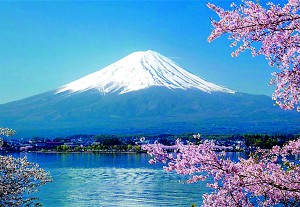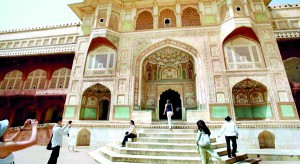Sunday Times 2
Rajasthan forts, Mt Fuji among new World Heritage sites
View(s):PHNOM PENH, June 22 (AFP) -PHNOM PENH (AFP) -Japan’s Mount Fuji, known for its perfectly cone-shaped volcano, was today granted World Heritage status, UNESCO said.

Japan's highest peak Mount Fuji, seen behind Lake Kawaguchi in Yamanashi prefecture (AFP)
Fujisan, the highest mountain in Japan at 3,776 metres (12,460 feet), is one of the country’s most recognisable sights. The iconic snow-capped peak “has inspired artists and poets and been the object of pilgrimage for centuries,” UNESCO said.
Italy’s Mount Etna, the Hill Forts of Rajasthan and the Namib Sand Sea were among the natural wonders and cultural jewels granted World Heritage status by UNESCO at its annual meeting on Friday.
Other entrants into the coveted list include the Mountains of the Pamirs in Tajikistan and China’s Tianshan range, in a move hailed by conservationists.
“From vast deserts in Namibia and Mexico to high mountain ranges in China and Tajikistan and a volcano in Italy, the new World Heritage Sites are a celebration of the beauty of nature and our joint commitment to conserve it for generations to come,” said Tim Badman of the International Union for Conservation of Nature.
The tallest active volcano on the European continent at 3,300 meters (10,900 feet), Mount Etna has been written about for 2,700 years and has “one of the world’s longest documented records of historical volcanism”, according to UNESCO.
The volcano, in the east of Sicily, is one of the most-studied in the world and “continues to influence volcanology, geophysics and other earth science disciplines”, UNESCO said.
“Mount Etna’s notoriety, scientific importance, and cultural and educational value are of global significance.”Situated near Catania, Sicily’s second city, the volcano, which is some 200 kilometres in circumference, was created by a series of eruptions beneath the sea off the ancient coastline of Sicily some 500,000 years ago.

Tourists visit Amber Palace in Jaipur, capital of India's desert state of Rajasthan (Reuters)
There are still periodic eruptions at the central crater. Lava flows down the sides of the volcano have sometimes threatened villages, which are built up to around 800 metres.
Catania city has been hit several times during eruptions, including being almost completely destroyed by one of the largest recorded eruptions in 1669, after which it was rebuilt in the Baroque style.
The Italian delegate to the UNESCO meeting told the committee members that they were “moved and touched” by the decision to recognise the volcano’s importance.
According to local legend, on Etna there is a sweet chestnut tree said to have once sheltered hundreds of horsemen during a storm.
The Kingdom of Sicily issued an act of “public protection” for the tree in 1745 — one of the world’s first recorded environmental protection actions.
UNESCO also inscribed the Namib Sand Sea, “the world’s only coastal desert that includes extensive dune fields influenced by fog”, to the World Heritage list.
“It is an outstanding example of the scenic, geomorphological, ecological and evolutionary consequences of wind-driven processes interacting with geology and biology,” UNESCO said, highlighting the richness of flora and fauna in the desert area in Namibia.
The six hill forts in the northwestern India were hailed as “the most authentic, best conserved and most representative sites of Rajput military architecture of Rajasthan region.”Other sites that won World Heritage status Friday included the El Pinacate and Gran Desierto de Altar Biosphere Reserve in Mexico thanks to their “dramatic combination of desert landforms, comprising both volcanic and dune systems as dominant features”.
The “highly diverse mosaic” of habitats in a “seemingly inhospitable” desert is home to more than 540 species of plants, 44 mammals, more than 200 species of birds and over 40 reptiles.
Follow @timesonlinelk
comments powered by Disqus

